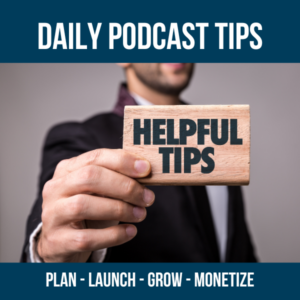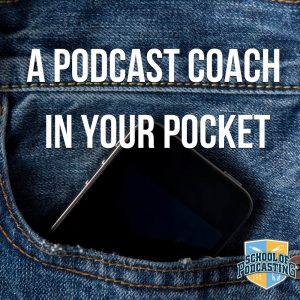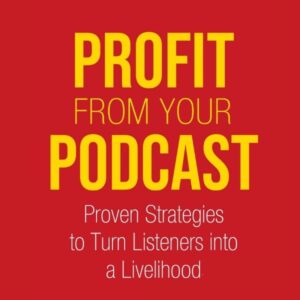
Every once in a while I get someone who wants to know how I created the School of Podcasting. How I created it back in 2005 is not how I would create it today. I'll explain that when I get to it, but I thought today I would share the tools and insights into building a podcast that uses the “freemium” model (deliver some content for free, with hopes people will sign up for your premium service).Please note that when available I've use affiliate links. I recommend these because I use them. I thank you in advance if you use these links to purchase these products.
Domain Name: Godaddy. I'm not a fan of their ads, but their service is great and easy to use. If you purchase a domain name, say “no thank you” about 1000 times to reject all the other services they try to sell you. You can check to see if a domain name is available using a search tool here.
Web Hosting: Host Gator. Why? You don't have to sign up for a year. They give you unlimited data (if you think you'll have more than one podcast, choose the option with unlimited domains). They have great service. When you go to their live chat they always have a HUGE number of people to help you. You can install WordPress easily, and if you ask them they will move your site for you. If you don't have a website yet contact me before you order, and I will set up WordPress for you.
Media Hosting: Libsyn.com Love their stats. Love their service. Love the fact that I have an iPhone app. Do you need a media host? Do you need air conditioning if you live in Texas? You don't need it, but it won't take long until you want it (and realize you should've got it in the first place).
Website Maintenance: WordPress. No other option comes close. It's free.
WordPress Plugins: Powerpress, Google xml, to get you going.
WordPress Theme: For years I used Thesis ($87). I love its flexibility, and ease of use. I love its built in Search Engine Optimization. I used it until mid 2010 when I switched to Optimizepress ($97). If you plan on having a membership site it makes it easy to navigate. I wish I had this when I first started the site.
Membership Software: To keep everything under lock and key I use Amember. It's a great piece of software ($179). However if I were to start the School of Podcasting today I would use Digital Access Pass ($167) because of its drip feature (and great technical support), or Magic Members ($97) which also has a great drip feature.
About the drip feature. If you are going to have a forum, you will probably want to shy away from using a drip feature as your new member will hear about information that they don't have access to view yet. The drip feature lets you time release (drip) content. For example on day one, let them see post one. On day two let them see (you get the picture). This makes sure you don't overwhelm people with information. It also stops them from signing up, consuming all your content over the weekend and walking away.
Another note about a memberhsip site. Realize that when you first start out you won't have an audience. Consequently, any time you spend on making “premium information” may fall on deaf ears (or no ears). This is where the drip feature is cool. You could create enough bonus content for a month, and then wait for the first person to sign up (as you would have four weeks until they ran out of material).
Payments: Paypal. I've only had two people over 6 years who really HATED paypal. With this in mind I also use 2checkout. I was using an “official” merchant account but unless you're making BOO FRICKIN KOO bucks, you will cry when you see the fees they sneak in on you.
Microphone: Electrovoice RE320. Currently I use the RE320, and for years I used a Sure SM58. I don't recommend condensor microphones or USB microphones as they force you to record directly into the computer. Some time in 2012 I will purchase a Heil PR 40. If you need some podcast equipment, contact me as I can often beat the pricing of most suppliers.
Mixer: Behringer Eurorack 802. This would be the Xenyx 802 today ($49). Nothing fancy. It does the job.
Software: Adobe Audition. the only reason I have this software is a listener gave it to me. It's cool, but not needed. I hate audacity as I've heard 400 too many “I lost my episode” stories from people using Audacity. What you don't pay in money, you pay in time. For the bang for your buck, I would go with Sony Acid (around $50) or garageband on the mac (free).
Favorite RSS Reader for Blogs: Google Reader as I can do this on my PC or phone.
Favorite “Podcatcher“: I love beyondpod for my droid phone. I cut the chord to iTunes.
Voicemail: Podcastvoicemail.com I like offering a toll-free number as people from around the world can use a Skype out number and (per Leo Laporte) call free. It's only $2 a month, and .06 a minute for any voicemail you receive. I don't think I've had a bill larger than $5 EVER.
Interview Tools: I use Skype to call people either over skype, or me on skype to their phone with a Skype Out number. I record the call to a Roland R-05 portable recorder ($199 at Amazon), and use PowerGramo software as a backup (professional verion $35).






I can help you make Skype calling a little cheaper. If you are needing to call the interviewee from Skype (you) to a phone (them) then just buy Skype credit. You can get $10 at a time and I think it now lasts indefinitely (it used to time out in 6 months or so if you didn’t use it all). Then when you call them you get deducted 2.3 cents per minute if you are calling a US number.
What you lose out on by doing it this way is that you don’t get a number they can call you at. You also lose the privilege of paying much more money than you need to.
Just add $10 credit to your account and start calling your interviewees on their regular phone.
It should be noted that while this is easy, it is not the best call quality you can get. You will get a fuller, richer sound from your interviewee if they are also using Skype with a good mic. But if they don’t know what Skype is or don’t have a computer, it is much simpler for them (and less risky for you) if you call them on a phone and don’t try to have them set up Skype just for your interview.